|
MORE DETAILS |
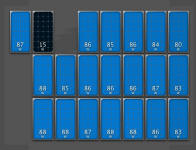
September 15, 2009
Thanks to the Enlighten feature that
allows you to play back the solar panel energy statistics graphically
over time I was able to clearly see that the solar panel on my solar
attic vent was causing a shading issue for over an hour in the late
morning.
|
 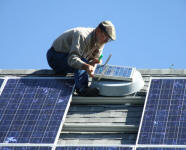
The solution was obvious, I just had to climb up and lower the panel so
that the shading issue was reduced. Now the panel on the vent will be
oriented toward the sun in the late afternoon rather than mid day, but
that is when the heat is highest in the attic, |
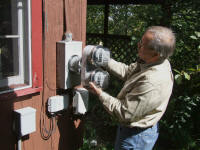 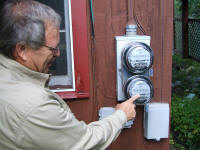
September 15, 2009
A Central Maine Power crew came out to replace the single meter with a
double unit that allows for 2 readings, energy delivered by them and
energy exported from my solar array to the grid. Russell from CMP shows how the new
meter will install (left) and points to the meter (right) that shows the
solar power being generated. Only one meter spins at a time indicating
which way the current is flowing at the time. As we watched one meter
would stop and the other would start as loads changed in the house.
This was before full sun was shining on the solar array, so the panels
were barely meeting our energy needs at the time. In full sun the
bottom meter spins quite quickly as we export energy to the grid. After
the sun goes down we import it back.
The meter is installed as part of the Net Metering Contract that I
signed with CMP, the company that delivers our electricity. There are
several reasons for this contract. First, the double meter gives CMP
statistics on how much power I am putting into the grid. They need this
data so they can report it to state and federal agencies as part of the
renewable energy portfolio for the state.
Secondly, this contract stipulates that I get full retail credit
for every kWh that I export. It is interesting to note that CMP's
computers do not have the capacity for crediting small residential
producers like me, so the billing has to be hand processed each month.
Keep in mind that due to deregulation, CMP does not generate power they
simply transmit and distribute it and handle billing for the energy
provider.
If we generate more than we use in any given month (likely to happen in
the summer months) then that credit is "banked" against future months.
Note: the dual meter was later replaced with a single Smart Meter
when the utility company upgraded to the new technology. A separate page is added to my bill showing energy
credits as they accumulate. |
December 15, 2009
 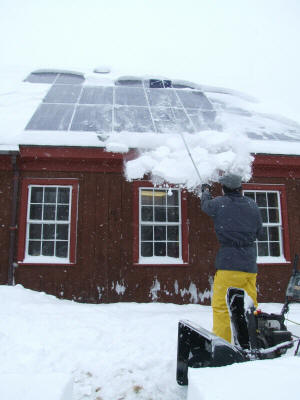
Another
learning opportunity came with the first 8 inch snow storm. I had to
clear the snow off the panels, so I went to the hardware store and
bought a snow rake for about $45.00. This tool has a plastic "shovel"
at the end of an extendable pole that assembles in 3 6 foot long
sections as needed. The panels are so far up that I added a broom
handle and still could not quite reach the top. I learned to be
meticulous, because any snow left on the panels will reduce the
performance as became very evident on the Enlighten web statistics. |
August 2010 - Adding
2 panels
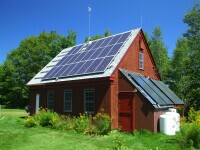 Thanks to the modularity of the Enphase system, I was able to add 2
more panels to my array today. Total installation time was
less than an hour. I climbed up and removed the panel clips on
the left edge of the 2 panels that would be adjacent to the new ones
first. Then I slid new bolts into the mounting rail to account
for the inverters and mid panel mounting bolts. I turned off
the array, bolted down the inverters and plugged them in, then with
my neighbor's help hoisted up the panels, plugged them in and bolted
them down, and powered the array back up. Thanks to the modularity of the Enphase system, I was able to add 2
more panels to my array today. Total installation time was
less than an hour. I climbed up and removed the panel clips on
the left edge of the 2 panels that would be adjacent to the new ones
first. Then I slid new bolts into the mounting rail to account
for the inverters and mid panel mounting bolts. I turned off
the array, bolted down the inverters and plugged them in, then with
my neighbor's help hoisted up the panels, plugged them in and bolted
them down, and powered the array back up.
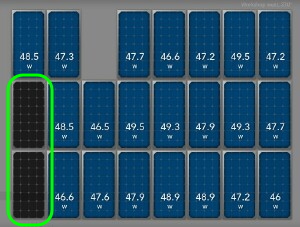
The next step was to call Enphase so they could tell the Envoy data
communications module to scan for the new modules. 10 minutes
later I accessed the Site Builder tool in my Enphase web portal
account and placed the new panels in the array and assigned the
module serial numbers to them - simple drag and drop stuff!
Shown at left are the 2 new modules before the statistics have caught
up with them.
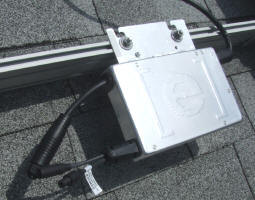
One thing I noticed about the newer Enphase M190 inverters is that
the female AC connector is now on a cable rather than mounted in the
box as they were in the ones I first installed. This
definitely adds flexibility in the installation! The added
length helps to account for uneven rail spacing and larger solar
modules.
|
September 2010 - Solar
shading effect of panels on the roof
The warm sunny weather recently caused me to consider whether there
is a benefit to having solar panels on the roof that reduce the surface
temperature on the shaded shingles. So I set up my
Hobo
Datalogger to find out. As you can see from the plot below the roof
stays up to 10 degrees F colder than the exposed roof surface.
Cool! Literally! So that is why I have used my small room
air conditioner a bit less this year. I guess the panels are not
just generating power they are saving it too!
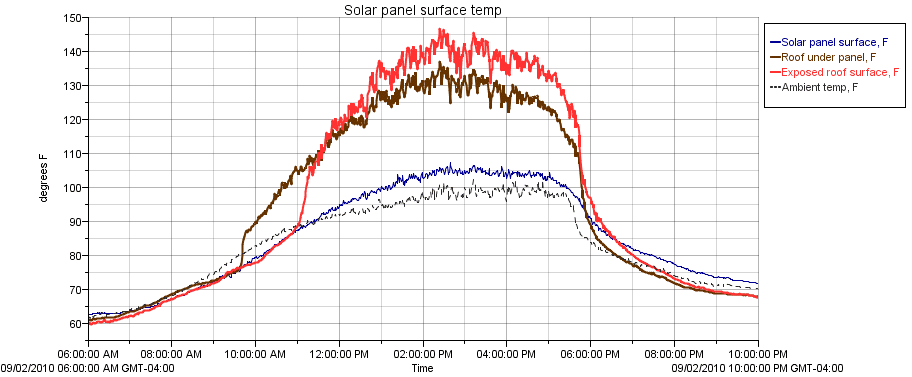
|
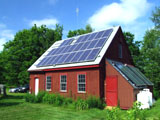 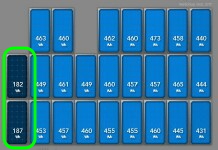
June 2011 - Added
2 more panels
Added 2 more BPSX175 panels. I got a good price on these as
they had been damaged when they blew off an installation and the
frames were bent. I straightened them out and siliconed the
front seams to prevent water and ice from seeping in around the
weakened seal. |
 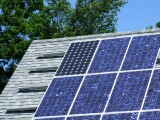
July 2011 - added 1 panel
Added a new 180 Watt BP4180 panel. BP no longer makes the
polycrystalline BPSX175 panel and now make a monocrystalline panel
with a white background that looks quite different. This
exemplifies the advantage of the Enphase micro inverters - you can
mix different panels in the system with no concerns. |

April 20 2011 - got smart meters installed
A woman from Central Maine Power installed 2 new Smart Meters today.
We're the last house in the neighborhood to get them for some
reason. Later this year CMP will be rolling our the web
interface so subscribers can monitor their usage. I'm looking
forward to that! |
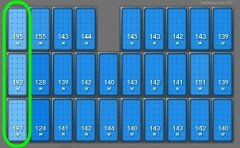 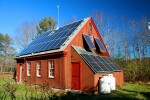
June 2012 - added 3 230 Watt panels
I added 3 Solar World (US made) panels with Enphase M190 inverters.
These panels are physically larger than the BP panels - so I had to
extend the rails by 12" using
IronRidge
rail splice kits. I am pleased that everything in my
installation was US made.
As the Enphase Enlighten interface shows at left, the inverter is
maxing out at about 197 Watts in full sun using the 230 Watt panel,
this means that I'm getting much more power overall from these
panels throughout the day. |
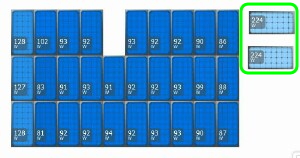  March
2013 - added 2 245 W panels on south wall March
2013 - added 2 245 W panels on south wall
I added 2 Solar World panels using the newer Enphase M215 inverters. While the inverter is nominally rated for at least 215 Watts, actual
output power as shown on left maxes out at around 224/5 W quite
early in the day as soon as the panels get full sun. I
tilted these panels at around 25° to keep the wind load low and
optimize snow clearing in the winter. I had to make my own
brackets to mount these to the wall of my building since there is no
standard racking equipment for angled mounting like this.
Later I learned that there was a poplar tree that was shading the
right panel in the morning, and cut
it down. |
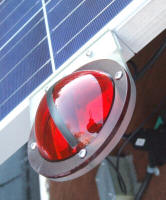 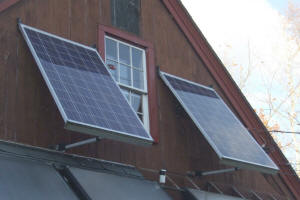 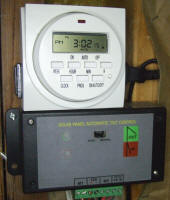 June
14, 2013 - I engineered my own solar tracking system for the 2 new
panels (see above). A sensor mounted to one panel tracks the
sun and sends control signals to a box inside which drives 2 linear
actuators that can tilt the panels in or out from the wall.
Due to limitations of the actuator lengths, the panels only actively
track the sun position from the fall solstice to the spring
solstice, providing optimal performance during the shortest
days of the year. June
14, 2013 - I engineered my own solar tracking system for the 2 new
panels (see above). A sensor mounted to one panel tracks the
sun and sends control signals to a box inside which drives 2 linear
actuators that can tilt the panels in or out from the wall.
Due to limitations of the actuator lengths, the panels only actively
track the sun position from the fall solstice to the spring
solstice, providing optimal performance during the shortest
days of the year.
|
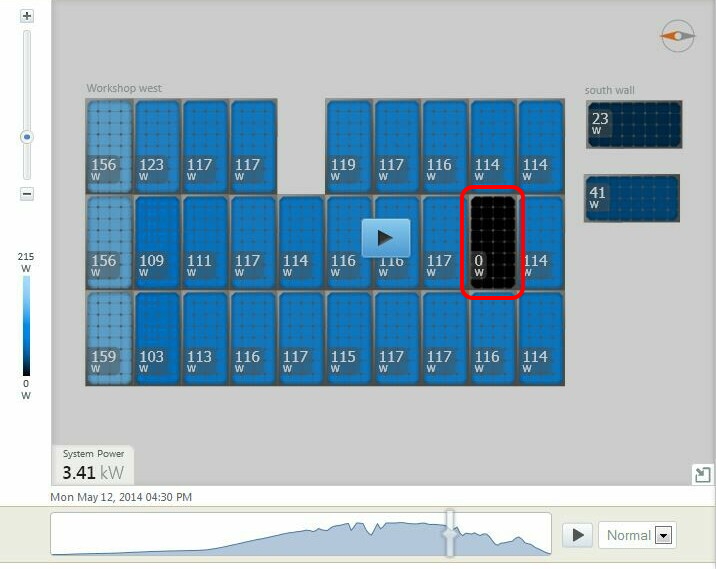
June 8, 2014. I noticed that my Enlighten web interface was
showing that one of my panels was dropping out and producing only 1
or 2 watts. Since there was nothing visibly wrong with the panel, I
contacted Enphase tech support to see if it was an issue with the
M190 micronverter. They attempted a fix by trying to download
new firmware to that inverter and when that didn't work, they issued
a replacement under their 15 year warranty. It was relatively
simple for my neighbor and I to go up on ladders, remove the panel
and replace the inverter underneath, just a few bolts and plugs. |
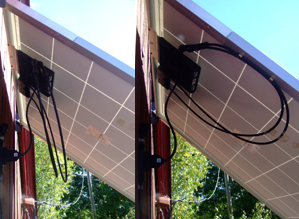
September
22, 2014. I had been bothered by the loose dangling wires
hanging off of the inverter and solar panels, and found a
company called
Nine Fasteners Inc. that makes these great little stainless
steel clips designed specifically to secure wires to solar panels.
This really neatens up my installation! |
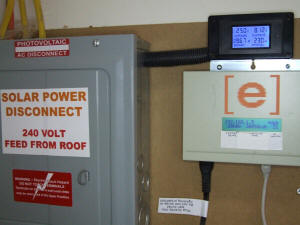  October
22, 2015. I found a nifty power meter that displays Volts, Watts,
Amps and cumulative kWh from a surplus store and installed it next
to the solar sub-panel. Photos were taken in the late
afternoon so it is not showing peak output which can be well over
4kW. October
22, 2015. I found a nifty power meter that displays Volts, Watts,
Amps and cumulative kWh from a surplus store and installed it next
to the solar sub-panel. Photos were taken in the late
afternoon so it is not showing peak output which can be well over
4kW. |

October
2016. A friend sold me a 245W Schuco panel for $100 and I installed
it on the south facing wall of my house with an Enphase M250
microinverter.
More details on my blog. It has the advantage of serving as a
shade for my bedroom windows in the summer. |
 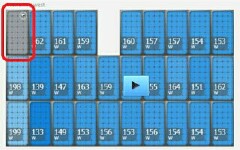
In
June 2017, another Enphase microinverter failed and they sent me a
replacement. This one was relatively easy to access.
More details on my blog. |
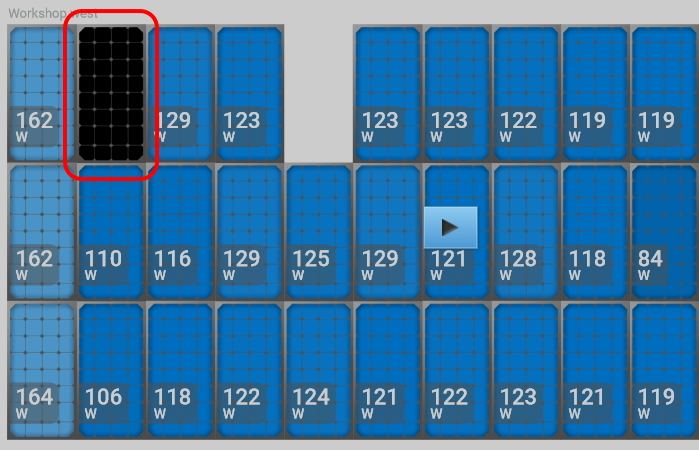
In
September 2018 another M190 microinverter failed. This one is
connected to a 180W BP solar panel. Enphase customer support
is impeccable and had a replacement to me in 4 weeks.
It seems these older model inverters are taking longer for them to
replace. I was a very early adopter, mine was the 1239th
system commissioned back in 2009. Now there are millions of
systems, some with thousands of inverters. |
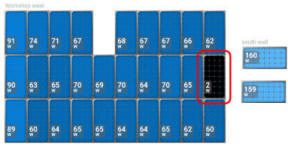 OK,
now this is getting tedious. Yet another Enphase M190
microinverter failed this week (November 18, 2018). This is
the 4th one in my original array that I installed 9 years ago.
I'm glad they have a 15 year warranty and that they are honoring it.
I'm paying the price for being an early adopter. They are now up to their
6th generation re-design and increasing
reliability. Hopefully the replacements will last longer.
At this time of year it is challenging to get up on the roof to
replace these devices when it's cold and there is snow on the
ground. My friend and I have to remove the solar panel to get
at the inverter to replace it. OK,
now this is getting tedious. Yet another Enphase M190
microinverter failed this week (November 18, 2018). This is
the 4th one in my original array that I installed 9 years ago.
I'm glad they have a 15 year warranty and that they are honoring it.
I'm paying the price for being an early adopter. They are now up to their
6th generation re-design and increasing
reliability. Hopefully the replacements will last longer.
At this time of year it is challenging to get up on the roof to
replace these devices when it's cold and there is snow on the
ground. My friend and I have to remove the solar panel to get
at the inverter to replace it. |
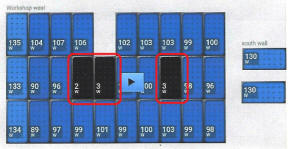
July 14, 2019 3 more inverters failed
. Replacements arrived a few weeks later, and I installed them on
September 12, 2019. This is 7 failed units out of 32 total
panels in my system. I have 5 more years of warranty, so I
hope the rest hang in there. |
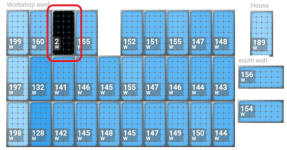 March 30, 2020 1 more inverter failed
. A replacement arrived a week after I filed a warranty claim. This is
8 failed units out of 32 total
panels in my system. I have 4 more years of warranty, so I
hope the rest hang in there.
March 30, 2020 1 more inverter failed
. A replacement arrived a week after I filed a warranty claim. This is
8 failed units out of 32 total
panels in my system. I have 4 more years of warranty, so I
hope the rest hang in there.
It is interesting that the new M190 inverter looks very different
from the originals and it takes multiple adapters - provided with
the kit - to get it compatible with my existing cables. |
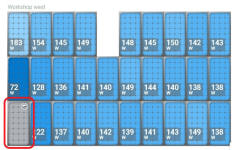 March 30, 2021 2 more inverters failed.
This is 10 failed units out of 32 total panels in my system.
March 30, 2021 2 more inverters failed.
This is 10 failed units out of 32 total panels in my system.
Replacements arrived April 20, installed April 24.
(Not shown in the image at left is a failed micro-inverter on the
right which I also replaced.)
Also, the solar panel above this is under producing by 50% so
swapped it with the one below and will continue to monitor its
performance. The panels are all still covered by the 25 year
warranty that is standard for most solar panels. |
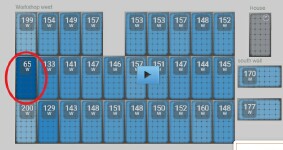 March 30, 2021
1 more inverter failed. I'm now up to 11 failed units!
this is a 33% failure rate so far. I'm glad these guys
continue to honor their warranty! March 30, 2021
1 more inverter failed. I'm now up to 11 failed units!
this is a 33% failure rate so far. I'm glad these guys
continue to honor their warranty!
After swapping two solar panels to diagnose why this panel or
inverter were underperforming, I determined it was the
micro-inverter in this case and not the panel. it is
tedious to replace these inverters, but fortunately I have a willing
neighbor and can borrow enough ladders to accomplish the task. |
  November
18, 2021
I replaced the 4 large solar collectors that I was using to heat my
workshop with 5 new REC 375W solar panels in the hopes that they
will fully offset the energy of the mini-split heat pumps I
installed in my house and workshop. I'm seeing max power from
these 5 panels at about 1500W at noon. I'm using the latest
technology IQ7A microinverters from Enphase. November
18, 2021
I replaced the 4 large solar collectors that I was using to heat my
workshop with 5 new REC 375W solar panels in the hopes that they
will fully offset the energy of the mini-split heat pumps I
installed in my house and workshop. I'm seeing max power from
these 5 panels at about 1500W at noon. I'm using the latest
technology IQ7A microinverters from Enphase. |

September
30, 2022 I added 1 more 375W panel to my new south
array because the new panels are not generating enough power in the
winter to offset the 2 heat pumps. My monthly bills for
December and January were over $300! However the 6
new panels had not accumulated KWh credits throughout 2021, so I
expect to have significant credits in 2022 that will offset the heat
pumps into the winter. |

March 30, 2021
1 more inverter failed and replaced. I'm now up to 12 failed
units! I have 2 more years on my 15 year warranty - then it will
cost me to replace these units...
|

November
2, 2022 - 2 more failed inverters replaced. Total failures now at
14 of the original Gen 1 units. That's about 50% that have failed
so far. The replacements are 7th generation units that should last
a while I hope! It's getting to be annoying to have to go up on 2
ladders with a friend, remove the panel and replace the microinverter
and replace the panel.
|

May
6, 2023 - 15th failed inverter replaced.
|
 November
16, 2023 - 16th inverter replaced. one failed in
September but I didn't notice it until early November. November
16, 2023 - 16th inverter replaced. one failed in
September but I didn't notice it until early November.
This is one that had already been replaced under warranty in September
2018 so it required a phone call to a guy in India who was able to
download new code to the gateway and the inverter to get it all working.
Isn't it amazing that someone on the other side of the planet can update
code in the devices on my roof! |
 October
7 2025 - 17th inverter failed. This is now more than half
of these 1st generation products! It took dangerous 3 trips up to
the roof to get this one working with the help of my friend/neighbor -
and enphase tech support. But then the 2 panels on the left
stopped working. These are no longer under warranty as of 2024 and
I have begged enphase to give me some latitude and honor all the
promotion I have done via my web site and blog. So they relented and
sent 2 replacements! October
7 2025 - 17th inverter failed. This is now more than half
of these 1st generation products! It took dangerous 3 trips up to
the roof to get this one working with the help of my friend/neighbor -
and enphase tech support. But then the 2 panels on the left
stopped working. These are no longer under warranty as of 2024 and
I have begged enphase to give me some latitude and honor all the
promotion I have done via my web site and blog. So they relented and
sent 2 replacements! |
 Update October 23,
2025 - they sent 2 replacements! I had mentioned this blog and the sales it
may have generated for them, so they are acknowledging that I think.
But the new inverters did not work and I'm getting tired of going up on
the roof with my friend to remove the panels and replace inverters.
It's dangerous work for me at 70 and john at 77, but we are both
comfortable working up high. John is a retired builder! Update October 23,
2025 - they sent 2 replacements! I had mentioned this blog and the sales it
may have generated for them, so they are acknowledging that I think.
But the new inverters did not work and I'm getting tired of going up on
the roof with my friend to remove the panels and replace inverters.
It's dangerous work for me at 70 and john at 77, but we are both
comfortable working up high. John is a retired builder!
The photo shows the view from the ground. John goes up from the
other side, sits on the ridge and helps remove and replace panels. He's
a great friend!
It turns out that the unit replaced on October 7 was not working right
and prevented the 2 new ones from producing. So we have moved it
to the far left (at the end of the string). Problem solved!
It must have been bad wiring in the 240V cable attached to that inverter
so power was not feeding through. |

November
12, 2025 - a week or so ago a 20th inverter failed.
So 60% of these inverters have failed over 16
years! Not a good track record. This one had already been
replaced under warranty on 5/15/19 but I somehow got a warranty
replacement again! It took my friend John about 30 minutes to go
up on ladders, remove the panel and the bad inverter and replace it with
the new one, then replace the solar panel. |
 This image shows the lifetime energy produced by the panels as of
November 2025. The
darker ones represent the inverters that I have replaced - so the energy
metrics reset from the date of replacement. So I have generated
over 100MWh which equates to a HUGE $ savings on my electric bills. This image shows the lifetime energy produced by the panels as of
November 2025. The
darker ones represent the inverters that I have replaced - so the energy
metrics reset from the date of replacement. So I have generated
over 100MWh which equates to a HUGE $ savings on my electric bills.
Other panels show variations due to partial shading or the actual
wattage of the panels. Most of the initial installation was
comprised of 175W panels, but the 6 new ones on the right are 375W.
|